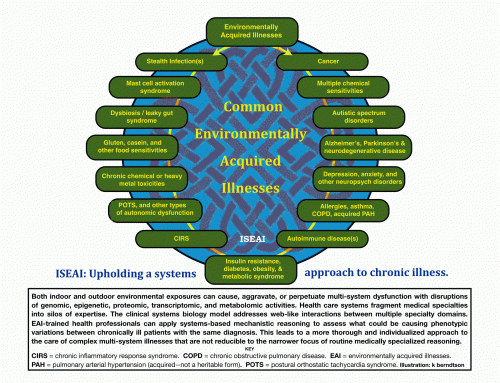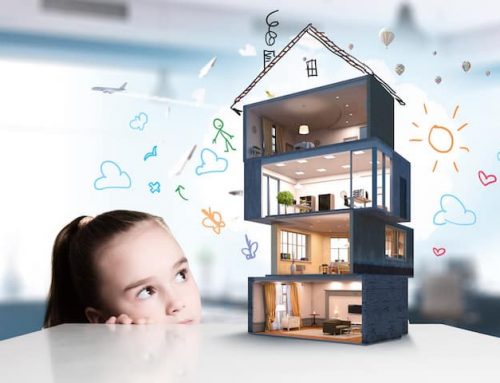By Jill Carnahan, MD, ISEAI Board Director. Dr Jill’s practice: Flatiron Functional Medicine. (Original Article)
The environment and human lifestyles are changing rapidly and our genetics haven’t kept up with these changes. Humans spend more time indoors and are exposed to more chemicals and contaminants than ever before, and this has a direct impact on our health.
Our homes are our safe havens – the place most of us feel comfortable and protected from the world. But what happens when your home becomes hazardous to your health?
This is the reality for a growing number of people struggling with environmentally acquired illnesses. These potentially life-changing conditions can be triggered by hidden harmful toxins lurking in their homes. But the good news is, if you’re concerned that you or a loved one may be battling an environmentally acquired illness, there are ways to deal with these harmful compounds hiding out in your home and sabotaging your health.
And one of our most powerful weapons in this fight is a group of specialists known as Indoor Environmental Professionals. Today we’re going to explore exactly how environmentally acquired illnesses can make you sick and how an Indoor Environmental Professional can help. Let’s dive in.
What Is an Environmentally Acquired Illness?
An environmentally acquired illness (EAI) is an umbrella term that encompasses multiple conditions. In a nutshell, an environmentally acquired illness is a chronic condition triggered by exposure to environmental toxins that may cause an inflammatory response in your body.
Just a few types of specific environmentally acquired illnesses include:1
- Chronic inflammatory response syndrome (CIRS)
- Mold illness
- Mast cell activation syndrome (MCAS)
- Multiple chemical sensitivity (MCS)
So how exactly can environmental triggers make you ill?
How Does Environmentally Acquired Illness Make You Sick?
When it comes to environmentally acquired illnesses, pinpointing the exact cause is not always so straightforward. You see, we’re all potentially exposed to a concerning amount of triggering toxins on a daily basis. Our bodies are designed with natural detoxification pathways to appropriately neutralize and excrete these toxins, but sometimes become overwhelmed.
Think of our “toxic load” as a bucket. We’re well equipped to handle a certain amount of toxins. But if we encounter more toxins than our “bucket” can hold, those toxins begin to overflow – and that’s where the trouble begins.
As this overflow of toxins begins to accumulate in your body, it triggers a cascade of inflammatory chemical messengers – sometimes causing widespread inflammation. And over time, repeated exposure may turn into chronic inflammation. This can cause damage on a cellular level, leading to debilitating chronic illness.
What Exactly Causes Environmentally Acquired Illness?
Some of the most common underlying triggers that contribute to environmentally acquired illnesses include:2
- Microbial growth (e.g. mold & bacteria) & related byproducts (mVOCs, mycotoxins)2
- Underlying persistent infections like Lyme disease, Bartonella, small intestinal bacterial overgrowth (SIBO), and Epstein Barr
- Toxic chemicals such as volatile organic compounds, BPA’s, parabens, PCB’s, and microplastics
- Heavy metals like lead, cadmium, and aluminum
- Air pollution (outdoor) from dust, pollen, agriculture wildfire smoke, automobile exhaust
- Air pollution (indoor) dust, carpet/rug fibers, laundry, dust mites, pets, cigarettes, etc.
- Indoor combustion sources such as stoves, candles, fireplaces
- Hormones, pesticides, herbicides, and fertilizers found in food
- Electric & Magnetic Fields (EMF)
Because exposure to toxins/contaminants can have a cumulative effect, it’s not uncommon for environmentally acquired illnesses to have more than one underlying trigger.
How Do I Know if I Have an Environmentally Acquired Illness?
Environmentally acquired illnesses can be tricky to diagnose for a couple of reasons. For one, symptoms of environmentally acquired illness can present as a number of vague, difficult to pinpoint, and seemingly unrelated symptoms. Just a handful of symptoms that can be caused by environmental toxins include:
- Brain fog and memory problems
- Headaches and sensitivity to light, sound, and/or touch
- Insomnia and/or poor sleep quality
- Anxiety, depression, and mood swings
- Fatigue and muscle weakness
- Muscle weakness and/or joint pain
- Respiratory issues like recurring infections, wheezing, and/or allergy symptoms
- Digestive upset such as diarrhea, constipation, nausea, and vomiting
- Skin problems including rashes, itching, blotching, and/or redness
Secondly, exposure to environmental contaminants may exacerbate other underlying conditions. Environmental toxins have been directly linked to causing and/or exacerbating a number of conditions, including:3
- Neurodegenerative diseases like dementia, Parkinson’s, and Alzheimer’s
- Metabolic disorders like diabetes, metabolic syndrome, and obesity
- Epilepsy and other seizure disorders
- Depression, anxiety, and other mental conditions
- Autoimmune diseases
- Cancer
- Digestive disorders such as Celiac disease, food sensitivities, leaky gut syndrome, and dysbiosis
- Respiratory conditions such as asthma, allergies, pneumonia, and COPD (chronic obstructive pulmonary disease)
- Skin issues like psoriasis and eczema
With such a vast array of symptoms and conditions linked to environmental toxins, you’re probably wondering how on earth environmentally acquired illnesses are diagnosed and treated.
How Are Environmentally Acquired Illnesses Diagnosed and Treated?
Diagnosing and treating environmentally acquired illnesses requires a big-picture approach that includes things like a thorough intake, laboratory tests, eliminating ongoing toxin exposures, healing your body, resetting your immune system, repairing your gut, and restoring hormonal imbalances.
If you’re concerned that you or a loved one might be struggling with an environmentally acquired illness, I cannot overemphasize the importance of seeking out the guidance of an experienced Integrative and Functional Medicine Doctor to help you identify and treat the root causes of your symptoms. Finding a clinician who specializes in treating environmental exposures can be a great help. Also see ISEAI’s Get Help page.
But healing your body is only part of the equation. When it comes to environmentally acquired illnesses, it’s equally as important to address the environmental factors that may be triggering your condition. This often requires a comprehensive evaluation of your environment to identify your exposures. Following this evaluation, you may need to take action to remediate or environmentally-clean the identified exposure.
And that’s where an Indoor Environmental Professional comes into play.
What Is an Indoor Environmental Professional (IEP)?
An Indoor Environmental Professional (IEP) specializes in indoor environmental assessments in relation to environmentally acquired illnesses. These professionals work closely with patients and their healthcare providers as well as homeowners, landlords, and architects to identify and address environmental concerns. Also read this ISEAI blog about finding an IEP.
What Exactly Does an Indoor Environmental Professional (IEP) Do?
If you’re concerned that your home is harboring toxins that are contributing to your environmentally acquired illness, a consultation with an Indoor Environmental Professional could be the next right step for you.
During the evaluation, your Indoor Environmental Professional would typically:4
- Discuss client/clinician concerns regarding specific environmental exposures
- Obtain an in-depth and detailed historical account of the building
- Review any documents from prior and/or related inspections or tests performed on the site
- Assess for any other documented history of past water leaks, damp conditions, damages, remediations, and/or cleaning efforts
- Thoroughly evaluate the environment using visual and real-time measurement devices, and potential sampling requiring lab analysis
- Compile a detailed report with their findings, interpretation of findings, and specific recommendations for your home
- Provide and utilize industry-standard documents and recommendations if cleaning or remediation efforts are indicated (e.g., IICRC S520)
- Closely monitor when additional services are needed to ensure cleaning/remediation efforts fully address the areas of concern in your home (if/as needed)
- Communicate with clinicians treating your environmentally acquired illness (if/as needed & agreed upon)
IEP’s are an essential resource for those suffering from environmentally acquired illnesses. However, not all IEP’s and their credentials are created equally. So it’s important to know how to find the right Indoor Environmental Professional for your situation.
How Do I Find the Right Indoor Environmental Professional?
While “Indoor Environmental Professional” is not a credential in itself, it encompasses a range of professionals that may be credentialed from a number of organizations. But only a handful of credentialing organizations are recognized for their excellent standards, integrity, stringent continuing education requirements, and in-depth knowledge of the complex interconnection between environment and health.
So before hiring an IEP, do your homework and make sure to hire a professional with a top-notch credential. Among these “gold-standard” certifications are:3
- ACAC: The American Council for Accredited Certification (For onsite assessments, look for ACAC candidates with CIEC and CMC
certifications. For remediation, look for ACAC candidates with CMRS and CMR certifications. Learn more about ACAC certification here.) - CIH: Certified Industrial Hygienist
- NORMI: National Organization of Remediators and Mold Inspectors
- AIHA: American Industrial Hygiene Association
- CSP: Certified Safety Professionals
If you’re concerned about the safety of your home or workplace, it’s essential that your indoor environmental evaluation is completed by a credentialed, knowledgeable, and experienced Indoor Environmental Professional who’s well-versed in working with clients suffering from environmentally acquired illnesses. Be sure to ask about this, as there may be special considerations during an assessment or remediation, depending on your sensitivities to various exposures.
If you need help locating an experienced Indoor Environmental Professional who understands chronic health concerns you can check out the International Society for Environmentally Acquired Illness database of vetted and credentialed professionals by clicking right here. Some companies even offer virtual consultations if you’re unable to find an Indoor Environmental Professional in your area!







Leave A Comment